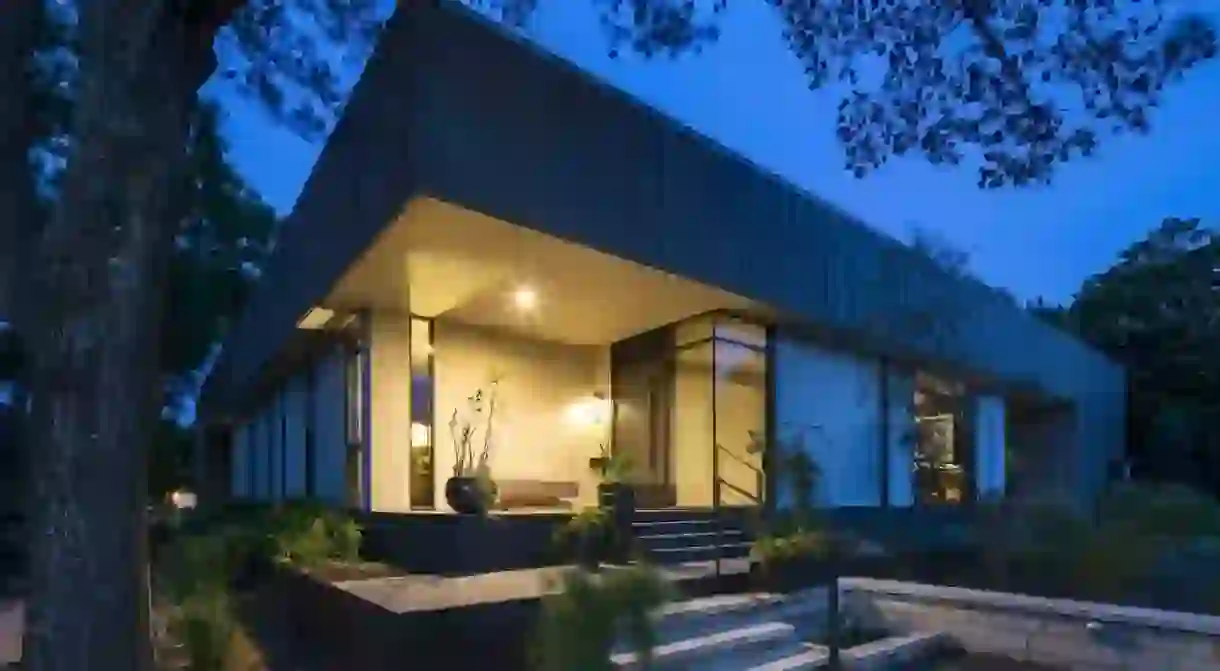Could This Be the Most Eco-Friendly Home in Austin, Texas?

Gradients of Green is the brainchild of designer Laura Britt. Constructed to the highest eco-friendly standards, the house in Austin is a model of sustainable design.
Texas has seen a surge in new residents and homeowners over the past few years, and the real estate boom doesn’t look like it’s slowing down anytime soon. But with all that new foot traffic in the Lone Star State, sustainable home designs and solutions are more important than ever.
The American Society of Interior Designers (ASID) conducted an in-depth case study on a single family home in Austin, Texas, to showcase the impact of eco-conscious, wellness-driven design. The original 1951 ranch-style house couldn’t be remodeled due to structural issues, so the home’s owner and designer Laura Britt donated the house to a family of 14 and began work on a new, ultra-efficient structure.

The 2,750-square-foot Austin home, dubbed Gradients of Green, focused on a variety of holistic “green” categories, such as energy efficiency, flexible spatial layout, water conservation and conscious product selection, and emphasized a connection to the outdoors. The challenge was to build a “sustainable, high-performing home” as a model for healthy design and living, led by WELL Building standards. Britt’s met the challenge and achieved not only LEED Platinum certification but also a five-star rating from the Austin Energy Green Building Program.
Here’s how she did it.
Air quality
Laura Britt and her son have a history of respiratory problems, making indoor air quality (IAQ) one of the highest priorities in her home. Britt utilized only zero or low-volatile organic compound paints, stains and adhesives throughout the home, as well as domestically manufactured furnishings made from sustainable and recycled materials.

Strong connection to the outdoors and flexible layout
Britt added an additional 1,000 square feet of exterior porch areas to the home, including a carport pavilion to increase the outdoor living area. The home’s U-shape configuration wraps around a large back porch and includes a “nationally certified landscape.” The living room is the focal point of the home with access to both the outdoor areas, kitchen and dining room.

Lighting
Britt had LED lighting installed (which uses 15 percent of the energy of conventional lighting). According to ASID’s report, “Daylighting strategies and considerations of solar orientation were incorporated throughout the building, ranging from large areas of protected glazing and skylights, to windows between interior spaces, to indirectly illuminated interior spaces.” Britt also used a Lutron control system to dim indoor lights and carefully planned exterior light fixtures to reduce “light pollution” during evening hours.
Applied healthy living features
Britt installed “appliances that preserve and prepare food using healthier methods” in the kitchen areas, including a steam oven, dual compressor refrigerator and a Gaggenau induction cooktop. She also utilized a water treatment system to remove impurities from the drinking water using reverse osmosis and installed an exterior metal roof for rainwater collection. In addition to this, a rainwater garden was “created by planting 98 percent heat- and drought-tolerant plants that absorb rainwater and distribute it,” as well as a drip irrigation system to keep plants watered.

Considering the future self
Aging is inevitable for all of us. Rather than hide from this truth, Britt designed the home so that it can accommodate usability for ages 8-80, to allow for “ageing in place.” Highlights include pathway egress lighting in hallways and walkways, an accessible ramp from the parking area, flush shower floors, indirect lighting in bathroom areas, supplemental reading lighting in the bedrooms and a contrasting color palette to aid visibility.

Energy efficiency
In addition to the LED lighting system with dimming controls and efficient appliances, Britt installed a solar-powered rooftop system and charging hookup for an electric car in the carport. Most impressively, the “solar array produces more energy than is consumed by the house,” earning the residence a five-star rating from the Austin Energy Green Building Program.
For more, check out this ASID study on why good office design matters more than you may think.













